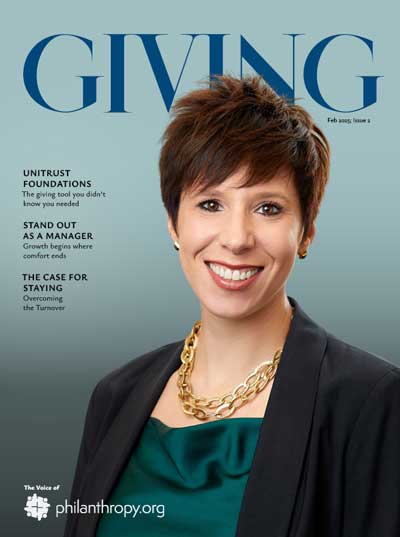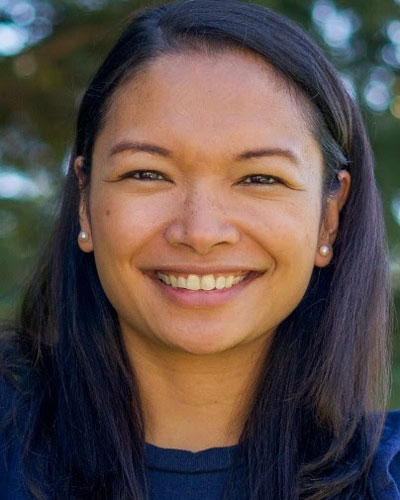
Gratitude isn’t just good manners. It’s not an afterthought. And it’s definitely not something to check off once the gift comes in. Gratitude is a strategy.
Gratitude That Sticks: How Smart Fundraisers Make Donors Feel Seen
Let’s be honest: We all know we’re supposed to thank our donors. The receipts go out. The letters get merged and mailed. Some of us even send handwritten notes or make follow-up calls. But for many nonprofits, gratitude ends up at the bottom of a very long to-do list, something we know is important but rarely urgent.
The thing is, gratitude isn’t just good manners. It’s not an afterthought. And it’s definitely not something to check off once the gift comes in.
Gratitude is a strategy.
It’s what turns a one-time donation into a long-term commitment. It’s what deepens trust, opens the door to more and bigger gifts (including planned gifts), and gives donors a reason to stick around when the next campaign rolls out.
For our November issue, we asked nonprofit professionals to share how they thank their donors, not just in theory but in their day-to-day work. The responses were honest, creative, and rooted in experience. Together, they show something many of us know but don’t always prioritize:
How your donor feels after they give matters more than how you asked for the gift in the first place.
Fast Thank-Yous That Feel Genuine
A quick thank-you can be the difference between a one-time gift and a lifelong donor. At Coal Creek Meals on Wheels, Brittany Vital makes timeliness and authenticity a core part of donor relations. “No matter the amount a donor gives, we make sure they receive their tax acknowledgement letter and a thank-you message as quickly as possible,” she says. Staff and board members add handwritten notes and make personal calls, often referencing the donor’s connection to the mission.
Peggy Glenn at Northeastern State University takes a similar approach with higher-level gifts. “For donors of $1,000 and up, our office prints labels and gives postcards to board members before each meeting. They add handwritten thank-you messages on the postcards. I’ve gotten great feedback from donors who receive these.”
At James Madison University, the Office of Planned Giving uses small, meaningful touches to bring donors back to campus. One February “Snow Day” email included a live stream of the historic Quad during a snowstorm. “There was no ask involved,” recalls Kathy Sarver, Director of Planned Giving. “Yet we received two substantial gifts and countless messages from alumni thanking us for reconnecting them to a special place.”
Making It Deeply Personal
The most memorable thank-yous don’t have to be the most polished, they just have to be the most personal. At Brooke USA, CEO Emily Marquez-Dulin builds personalization into every stewardship plan. For one major donor, that meant an annual tradition of elaborate mango-themed birthday gifts, based on a personal detail discovered early in the relationship. “Our best advice: show gratitude in the way your donor wants to receive it,” she says. That thoughtful approach helped secure a $500,000 gift.
James Madison University’s Thanksgiving cards for legacy donors are another example. Each fall, the Office of Planned Giving sends cards featuring recipes from the university archives, such as “Flapper Pudding” and the infamous weekly liver and onions. Cards are designed in-house, hand-signed by staff, and meant to spark campus memories.
And Wayne Olson, now president and CEO of the Winter Haven Hospital Foundation, recalls a special thank-you he created earlier in his career, when he was a senior development staffer at a university. He gifted a beloved, terminally ill donor a 120-year-old steel bolt from a campus building, a tangible and unique piece of the place the donor cherished.
“He loved it,” Wayne said. “I even believe he was buried with it.”
For Gary Bukowski of Sarah A. Reed Children’s Center, honoring one donor’s legacy meant creating something permanent. “She was a librarian who carried a big philanthropic stick,” he says. After she left a planned gift through her retirement fund, they created a dedicated reading nook in the Hammermill Library, complete with her picture and inspirational words. “She never asked for recognition, but I felt she deserved to be recognized for her planned giving action.”
Mark Olson at Treasure Coast Hospice Foundation tells a similar story of honoring even the smallest gifts. After a third-grade class raised $166 by selling handmade bookmarks and trinkets, Olson and the entire foundation signed a thank-you card. “Genuine thank-you notes change lives,” he says. “They bring you back to your good deeds and encourage you to go back out there and do it again.”
Letting Others Do the Talking
A thank-you from development staff is great, but when a donor hears directly from a program leader, board member, or someone affected by their gift, it can be even more powerful.
Eric Wilbanks of Boys & Girls Clubs of the Ocoee Region applies “Giftology” principles to craft deeply personal, handmade gifts. For one donor, he created an ornament of a spool car, just like the ones she made as a child. “That inexpensive, thoughtful gift did more for our ongoing relationship than anything else we could have done,” he says.
At Hurricane Island Outward Bound School, Rachel Loomis Lee sends “HIOBSaversary” cards to alumni on the anniversary of their expeditions, no matter how long ago. One recipient, 60 years out, replied, “Outward Bound? Still one of the best things I’ve ever done.”
At Edmonton’s Food Bank, Tamisan Bencz-Knight keeps gratitude simple and human. “We send a formal letter, but also a handwritten card from our Executive Director or a key manager, sometimes with a thoughtful quote about giving,” she says. They also extend open invitations for private tours. “This approach helps us build genuine relationships. Donors become more than donors and transition to ambassadors, collaborators, and friends in our mission.”
Gratitude as the Start of a Relationship
Some of the strongest donor relationships begin with a thank-you and then grow through consistent, intentional stewardship. Dr. Sanjay Bindra of GOSUMEC Foundation USA tells the story of Dr. Anil and Minal Modi, whose initial $100,000 pledge grew into multiple scholarships and a long-term partnership because of genuine connection. “For us, gratitude isn’t transactional, it’s an invitation into community,” he says.
Jessica Jersey of Atlantic General Hospital Foundation launched a video series recognizing “perpetual donors” who give consistently year after year. Donors Don and Corrie Boger, for example, sponsor two of the foundation’s three major events annually. “We wanted to highlight that impactful giving isn’t always about the size of the gift, it’s about consistency and belief in our mission,” Jersey says.
Small Gestures, Big Results
Not every thank-you has to be grand to be effective. Some of the most impactful gestures are also the simplest.
At Valley Forge Park Alliance, Allie Kochinsky invited top donors to a private, behind-the-scenes tour of the historic Washington Memorial Chapel, followed by an intimate reception. One guest became a volunteer, another helped launch new programming.
At the Pacific Southwest Railway Museum, Donna Spevack combines the practical, like tax letters and early bird event tickets, with the personal, like casual “meet and greet coffees” outside her caboose office. “The best way to show donors you care is still the old-fashioned way, a phone call to just say hello,” she says.
Faithful Friends Animal Society has shown that meaningful recognition can also be joyful. To celebrate the birthday of a founding volunteer in memory care, they brought her favorite thing: kittens. “These tiny ambassadors of our mission joined us for a special visit that brought joy not only to her, but to the residents and staff who gathered to meet them,” recalls Shannon O’Neill. For a top fundraiser who requested no physical gifts or public recognition, the team recorded short video messages of thanks while holding shelter animals. The result was a deeply personal tribute that cost nothing … but meant everything.
Creative and Unexpected Touches
Sometimes a thank-you surprises a donor so much that it becomes a story they will share for years.
At the Delaware Art Museum, Legacy Society members receive books tied to exhibitions, like a Cab Calloway biography during a show on Jazz Age Illustration. “Sometimes it’s the tried and true activities that work the best,” says Advancement Officer Joshua Liss.
At Imprints of Honor, a veteran donor was honored with a custom keepsake featuring his personal challenge coin alongside the organization’s and that of a Medal of Honor recipient who once saved his life. “Authentic, creative gratitude ensures donors feel truly valued,” says CEO Vicki Stouffer. The gesture was so meaningful that the donor made his scholarship permanent and added the nonprofit to his estate plans.
Gaylord Specialty Healthcare honored a donor family’s generosity by commissioning a life-size statue of Apollo, a beloved therapy dog, for the hospital’s healing garden. “This piece deeply moved the donors and resonated across the Gaylord community,” says Development Associate Kaitlyn Koch.
Prison Fellowship International chose to replace a standard year-end letter with a mini impact report. “The theme was simple but heartfelt,” says Kristi Padley. “You joined us. You helped make these testimonies possible.” Donors responded warmly, and several sent additional year-end gifts.
The Bottom Line
Whether it’s a mango gift box, a snow day livestream, a kitten cuddle, or a quiet phone call, genuine gratitude works because it’s intentional, personal, and human. As fundraising coach Claire Axelrad reminds us, “Help your donor feel they mean more to you than even they thought they did. The first thank-you is only the beginning. Show gratitude all year long, not just with a transaction receipt.”
The most enduring donor relationships are built not on asks, but on appreciation. Because in the end, it’s not just about the money. It’s about the relationship. And the relationships that last are the ones you nurture, day after day, year after year, with gratitude that sticks.
-
Michelle is a seasoned nonprofit development professional with over a decade of experience in fundraising strategy, donor communications, events, and relationship building. She has designed and managed high-impact campaigns, built strong stewardship programs, and cultivated lasting partnerships to advance mission-driven goals.
She is also GIVING magazine’s editorial assistant in charge of Outreach and Research. At Philanthropy.org, she leads content strategy and contributor outreach, ensuring each piece reflects the authenticity and urgency driving today’s philanthropic sector.
Michelle began her career at the Michael J. Fox Foundation, where she helped raise over $6 million annually. Since then, she has led development and stewardship initiatives for organizations including buildOn, One Love Foundation, Americares, Second Wind Fund, and Rise Against Suicide.
She holds a Master of Science in Nonprofit Management from The New School University.
View all posts

GIVING Magazine
For those who drive change — not watch it. Join the top 1%.
